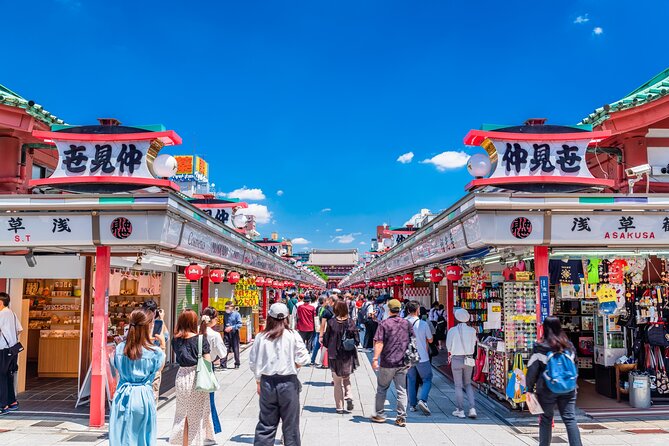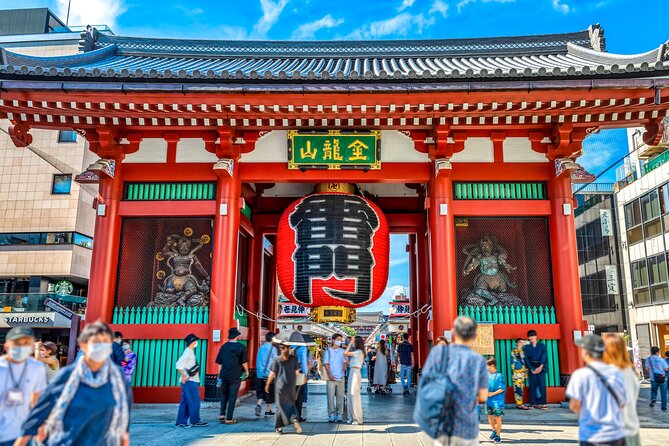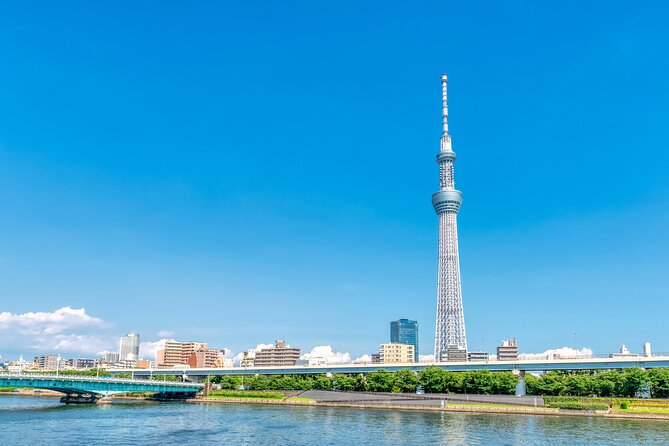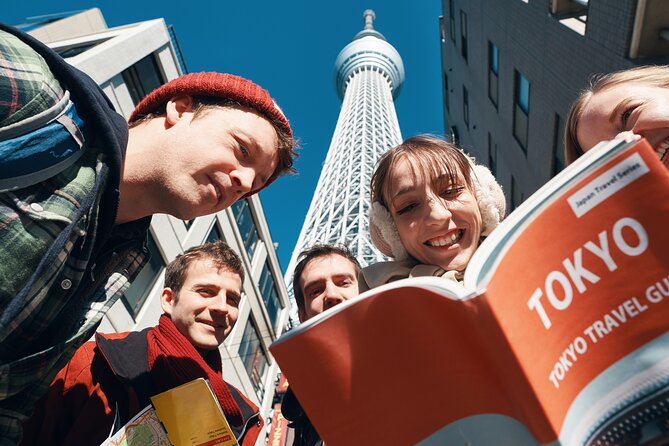Discover Tokyo’s hidden gems and time-honored tales on the ‘Historical Walking Tour of Skytree and Asakusa.’
Uncover the secrets behind Tokyo Skytree’s towering presence and Asakusa’s ancient charm as you stroll through the city’s historic streets.
Learn about the cultural significance of each landmark and savor traditional treats along the way.
The journey promises a blend of history, culture, and breathtaking views, making it an ideal exploration for those seeking a deeper understanding of Tokyo’s past.
Key Takeaways
- Explore Tokyo’s rich history and culture through visits to Tokyo Skytree and Asakusa.
- Immerse in traditional Japanese architecture, craftsmanship, and sweet delicacies along the journey.
- Experience the symbolic Kaminarimon Gate and serene Senso-ji Temple for a historical perspective.
- Stroll through Nakamise Shopping Street for unique handicrafts, delicious street food, and a cultural immersion.
Tour Overview

Embark on a journey through Tokyo’s rich history and vibrant culture with the Historical Walking Tour of Skytree and Asakusa. This tour offers a perfect blend of old-world charm and modern marvels.
Tour highlights include a visit to the iconic Tokyo Skytree, where travelers can enjoy panoramic views of the city skyline. Cultural insights await at Asakusa, known for its historic Senso-ji Temple and traditional Nakamise shopping street.
Immerse yourself in the beauty of Japanese architecture and craftsmanship while sampling delicious traditional sweets along the way. This budget-friendly excursion promises an enriching experience for those eager to explore the heart of Tokyo’s past and present.
Asakusa Station Meeting Point

Travelers participating in the Historical Walking Tour of Skytree and Asakusa will find the staff waiting in front of Burger King at Exit 4 of Asakusa Station, located at 2-chōme-20-8 Kaminarimon, Taito City, Tokyo 111-0034, Japan.
Asakusa Station is a bustling hub with convenient access to nearby attractions like Senso-ji Temple and the Nakamise shopping street, perfect for exploring after the tour. For those looking to try local cuisine, the station area offers a variety of traditional Japanese eateries where you can savor delicious treats such as tempura, sushi, and ramen.
After meeting at Asakusa Station, travelers can indulge in the vibrant food scene before embarking on their historical journey through Tokyo’s iconic landmarks.
Kaminarimon Gate
Upon passing through the bustling streets of Asakusa, visitors will encounter the iconic Kaminarimon Gate, marking the entrance to a historical journey through Tokyo’s vibrant past.
-
Cultural Significance: The Kaminarimon Gate, translated as ‘Thunder Gate,’ is the outer gate of Senso-ji Temple, symbolizing protection from evil spirits.
-
Architectural Details: This striking structure features a large red lantern, called Chochin, that hangs from the center of the gate, representing a beacon of light and hope.
-
Historical Charm: Visitors can admire intricate wood carvings and statues of Fujin and Raijin, the gods of wind and thunder, on either side of the gate, showcasing traditional Japanese craftsmanship.
The Kaminarimon Gate stands as a symbol of Tokyo’s rich heritage and provides a captivating glimpse into the city’s cultural tapestry.
Senso-ji Temple

Passing through the Kaminarimon Gate leads visitors to the majestic Senso-ji Temple, a historical gem nestled in the heart of Tokyo’s Asakusa district.
The temple, built in the 7th century, boasts stunning architecture that reflects traditional Japanese design. Visitors can admire the vibrant colors and intricate details of the temple’s structures, providing a glimpse into Japan’s rich cultural heritage.
Senso-ji Temple isn’t only a place of worship but also a hub of cultural activities, such as traditional ceremonies and festivals. As one of Tokyo’s oldest and most significant temples, it continues to attract tourists and locals alike, offering a serene escape from the bustling city life while immersing visitors in Japan’s captivating history and culture.
Nakamise Shopping Street
Meandering through Nakamise Shopping Street unveils a vibrant array of traditional Japanese souvenirs and snacks, enticing visitors with its bustling atmosphere and cultural offerings.
-
Local Artisans: Discover unique handicrafts crafted by skilled local artisans, providing an authentic taste of Japanese culture.
-
Street Food: Indulge in a variety of delicious street food options, from savory senbei crackers to sweet dorayaki pancakes, satisfying your taste buds without breaking the bank.
-
Cultural Experience: Immerse yourself in the rich history of Asakusa as you stroll along this lively street, lined with shops selling everything from colorful kimonos to intricate fans.
Whether you’re looking for a special gift to take home or simply want to soak in the local atmosphere, Nakamise Shopping Street offers a delightful experience for all.
Tokyo Skytree Viewing Deck
As you ascend to the Tokyo Skytree Viewing Deck, prepare to be captivated by breathtaking panoramic views of the cityscape below. The deck offers an unparalleled vantage point, allowing visitors to see Tokyo stretch out in all directions.
For the adventurous, there’s even a glass floor section that provides a thrilling perspective straight down to the ground. The 360-degree views encompass iconic landmarks like the Tokyo Tower, Sumida River, and even glimpses of Mount Fuji on clear days.
Whether it’s day or night, the scenery from this elevated platform is sure to leave a lasting impression. Don’t forget your camera to capture these stunning vistas as you soak in the grandeur of Tokyo from above.
Frequently Asked Questions

Is the Historical Walking Tour Suitable for Children?
Children can engage in the historical walking tour, offering educational value. It is suitable for young learners and budget-friendly. The experience provides interactive learning opportunities while exploring Tokyo’s rich history and culture.
Are There Restroom Facilities Available Along the Tour Route?
Yes, restroom breaks are available along the tour route, addressing accessibility concerns. Travelers can find convenient facilities for comfort. The tour ensures a budget-friendly and informative experience while accommodating essential needs.
Can Participants Bring Their Own Snacks or Drinks on the Tour?
Participants can bring their own snacks and drinks on the tour. However, they should consider food restrictions and picnic options. It’s a budget-friendly way to enjoy the experience while staying refreshed and energized throughout the journey.
Is There a Dress Code or Recommended Attire for the Tour?
There is no strict dress code for the tour, but wearing comfortable shoes is recommended. Participants should dress casually and appropriately for walking. Comfortable footwear ensures an enjoyable experience exploring Tokyo’s sights.
Are There Any Specific Cultural Customs or Etiquette That Participants Should Be Aware of During the Tour?
Participants should respect bowing etiquette in Japan and use common cultural greetings like "Konnichiwa" (hello). When taking photos, be mindful of privacy and always ask for permission. Consider carrying a language translation app for easy communication during the tour.
Conclusion
In conclusion, the Historical Walking Tour of Skytree and Asakusa is a must-do for history buffs and culture enthusiasts alike.
With knowledgeable guides, traditional Japanese sweets, and iconic landmarks like the Tokyo Skytree and Senso-ji Temple, this tour offers a budget-friendly way to delve into Tokyo’s rich heritage.
Don’t miss out on this immersive and educational experience that promises to leave you with lasting memories of Japan’s fascinating past.
